“What’s the best scope for an AR-15?”
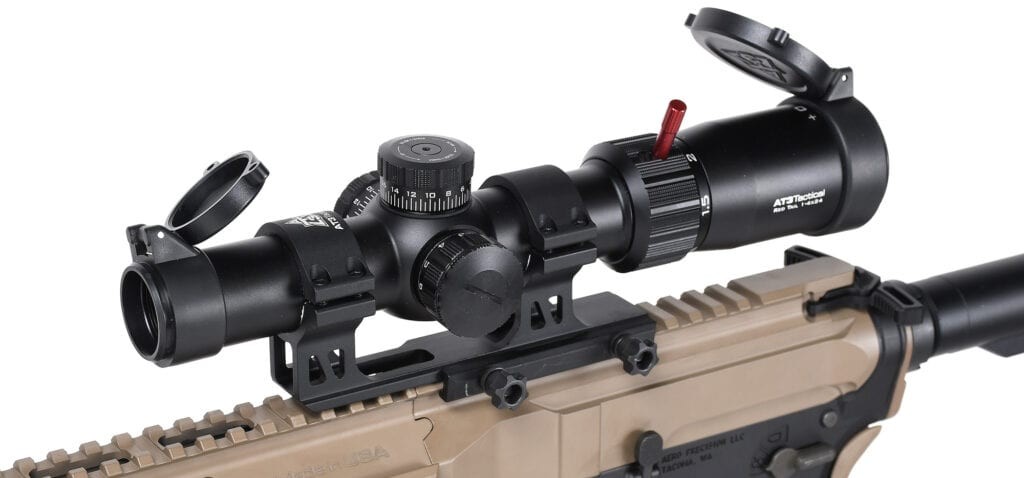
That’s a common question, with too many answers. It has too many answers because it’s the wrong question. The question you should be asking is, “What’s the best scope in my price range for my AR-15 doing a specific kind of shooting?” Let’s start with that. Remember, no one scope is best for everything. Some manage to be good at several things, but the laws of physics and optics inevitably force compromises.
- Shooting 100 yd targets?
- Sniping at 600 meters?
- Competing in 3-gun events?
- Killing gophers on the ranch?
- Taking on a five-day hunting trek?
- Taking into combat in a war zone?
Each of these is a dramatically different mission, and each has its own requirements. There are some general principles, though, that you can usually depend on. And, naturally, there are exceptions.
First: A more expensive scope is usually made better.
Made of better materials, built to more precise tolerances, with better optics. They are also usually better sealed against the elements, more durable, and often heavier.
Second: A larger objective lens — the glass facing your target — can gather more light.
This means a brighter sight picture for you, especially in low light conditions, and that can make the difference between identifying a target and losing a shot. Of course, that big lens adds to the weight. Glass is heavy.
Third: A larger tube allows more light transmission and usually enables more adjustment for windage and elevation.
But again, a 30mm tube will weigh more than a 1-inch (25.4mm) tube. More importantly, the cross-sectional area is about 39% greater, which means all the glass inside that tube will be at least 39% heavier, and probably more.
Fourth: There’s really no reason to buy a scope that can outrange the ammo you’re shooting.
Remember, even good .223 or 5.56 ammo is running out of kinetic energy at 600-700 meters. If you go to something like .300 Blackout, you might get another 100-200 meters of effective range from it. If you have an AR-10 (or other .308 weapon), 1000 meters is possible. Either way, your AR won’t be making bullseyes at a mile like a Barrett .50 might in the right hands.
Get a scope that can work at the maximum range you’ll shoot, but remember all that adds size, weight, and cost – so don’t buy more scope than you can use.
Fifth: Lower magnification means wider field of view, which means it’s easier to acquire your target and keep on top of the situation around it.
Higher magnification means you can watch things farther away, and potentially more ease in observing or identifying your target once you’ve acquired it. While a variable power scope offers both options to some degree, it’s optically more complex, which again means greater weight and cost.
You notice the pattern in the downsides of each of these: Weight and cost.
Weight matters: A 19-ounce scope might not feel like much in the gun shop, but when you’ve hiked for three days with the rifle on your back — or in your hands — you may wish you’d chosen the 11-ounce scope instead.
Not only that, but adding that much mass above the rifle’s bore axis can’t improve the handling, and a heavier weapon is always slower to move in your hands.
Most of us don’t have an unlimited budget, so cost is another important parameter in choosing your scope. It would be good to decide how much you WANT to spend on a scope, and what’s the most you’d be WILLING to spend on it.
Remember: While more expensive often equates to better, there are exceptions.
SCOPES AND NUMBERS
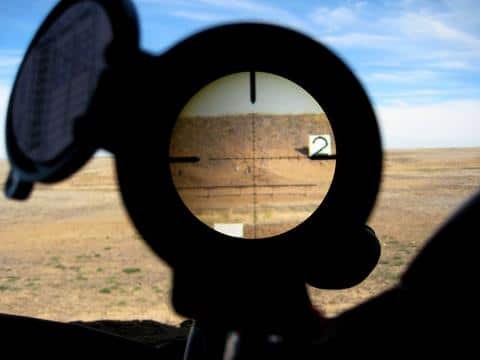
Most scopes are designated first by a few numbers, like “6x 43mm”, or “3-9x 40mm”, or “3-20x 50mm”. The first number or range of numbers is the magnification “power” of the scope, where “6x”, or “6 power”, means it makes the target appear six times larger. “3-9x” or “3-20x” would designate variable power, like a zoom lens on a camera. The last number refers to the diameter, measured in millimeters, of the objective lens — the lens facing your target, or objective. A smaller objective lens makes a scope light and easy to handle; a larger one gathers more light for a brighter view, especially in low light conditions.
Fixed focal length Scopes
Fixed focal length scopes, like the 6x mentioned above, are generally less expensive and more compact than variable optics. While lacking the versatility of a variable scope, they can and do provide a good alternative.
Also, given their optical simplicity, a 6x fixed scope might provide a brighter view, better clarity, or less distortion than a more complex variable scope set at the same power.
Variable Scopes
Variable scopes come in a huge variety of powers, and the highest-power isn’t always the best for all purposes. While long-distance shooting can make use of scopes with 30x or more, the majority of shooting is done at ranges under 300 meters, frequently much less than that.
For combat use, or events like 3-Gun that simulate combat, a lot of useful shooting is done at ranges where even 1x (zero magnification) is good enough; all you need is the aiming marks on the reticle. The ability to keep both eyes open for a wide field of vision gives you situational awareness, while at 1x the optic can still help you place your shots accurately.
This has made 1x optics like Eotech and Aimpoint very popular, and those are covered in another article. But if you must transition quickly from short to medium range shooting, you might be best served by a low-power zoom, starting at 1x, such as a 1-4x or 1-6x.
Mid-range variable scopes don’t offer the both-eyes-open shooting option, but they can provide very useful magnification for the vast majority of shooting at a reasonable price. 3-9x is a very common size, but some of the more expensive scopes can offer up to 3-20x.
Scopes for long-range shooting are offered with extreme magnification of up to 40x or 60x. Of course, these scopes tend to be big, heavy, and expensive, and their field of view is so narrow as to be all but useless at close range. If you’re planning to shoot at long ranges, though, there is no substitute.
RETICLES
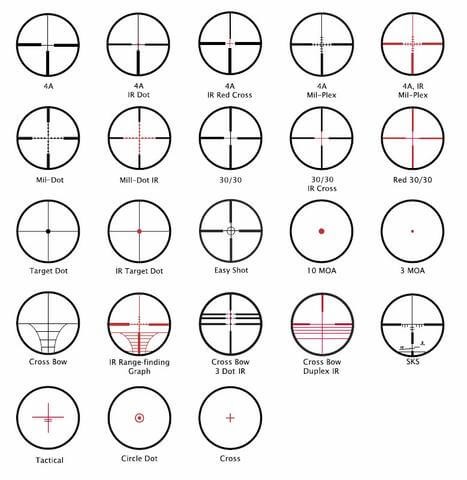
Once it was just a simple cross-hair.
Then cross hairs with calibrations. Now it seems that everybody has their own reticle designs, and it can get confusing. But there are some common elements to use as a basis for comparison.
(By the way: It’s “reticle”, not the common but incorrect “reticule.”)
The reticle, of course, refers to the aiming marks you see within the scope, overlaying the target image. This is actually what the scope is all about because that’s what shows you where the projectile will (theoretically) hit. Without a good reticle, you might as well use binoculars.
Since a reticle is technically independent of the optics that magnify the image, scope makers can put pretty much any kind of reticle they want in a scope.
Types of Reticles
Some scopes are offered with different reticles as options, which can actually simplify the choice: First, you choose the optics, the variable power range, and then select from the reticles offered by the manufacturer.
- Crosshair reticles
The first and simplest design is the basic “cross-hair,” horizontal and vertical lines that intersect at the center. Reticle designers soon figured out that they can show you more than that – for instance, holdover marks are marks, usually on the cross-hairs, at precisely calculated points.
The theory is that you can use them to adjust for elevation or windage – once you have a known range and wind speed, you hold the appropriate holdover mark over the target, rather than messing with the scope’s elevation and windage turrets. You can also use the windage marks to “lead” a target moving across your scope at a constant rate.
- BDC Reticles
A bullet drop compensator (BDC) reticle has a very specific type of holdover marks, a series of secondary marks going down the vertical line from the center. These are calculated to compensate for the ballistic curve of the flying bullet at longer ranges.
If you know the range for each mark, and the distance to your target, you can simply hold the correct mark over your target, and your elevation is corrected for the drop. Some scopes for the AR market are specifically set up to match, for instance, the trajectory of a 55 grain .223 bullet from a 16″ barrel, making it very easy.
- Other Reticles
Others present you with charts or a website to calculate the exact ranges for your weapon and ammo.
Mil-dot reticles look like cross hairs with a string of beads across them. These are the mil-dots, spaced 1 mil apart on center, and they’re the standard in military sniper use — but “mil-” isn’t short for “military.” Instead, it’s short for “milliradian,” which is 1/1000 of a radian, another mathematical way of measuring angles.
Without going into the complex math involved, one mil-dot, as marked on the reticle, equates to (technically speaking, subtends to) 3.6 inches at 100 yards, or 36 inches at 1000 yards.
With this knowledge and an estimate of the size of the target, a trained shooter can use the spacing of the mil-dots to form a pretty accurate estimate of the range. Originally developed in the 1970s for Marine snipers, this also works well with metric measurements (since everything is divided by 1000) and with the Military Grid Reference System, that’s standard across NATO.
Because of the way mil-dots and similar systems are used for range estimation, it leads us to the next topic:
First Focal Plane (FFP) and Second Focal Plane (SFP) Reticles
You may hear talk of “first focal plane” and “second focal plane” scopes. This applies only to variable power (zoom) AR-15 scopes and refers to where the reticle appears relative to the target. (Boring technical note: An optical engineer would tell you that we’re actually speaking of the second and third focal planes in the scope, as the first focal plane is the province of the “erector,” an optical element that flips the objective lens’ inverted image back to right side up. But since it’s common terminology, we’ll do like everyone else and ignore that focal plane.)
In a first focal plane (FFP) scope, the reticle is placed before the elements that zoom inside the scope — meaning that when you dial from 4x to 8x, the reticle itself also zooms, and doubles in size. This is commonly found on scopes with range estimating functions, such as the mil-dot reticles, because where those dots appear must remain constant relative to the image.
In a second focal plane (SFP) scope, the reticle is placed after the zoom elements, closer to the ocular lens, and its apparent size remains constant as the image zooms.
Unless you’re using the range estimating functions of the reticle, a constant reticle image can be easier to use. If a second focal plane scope has estimating functions, such as a bullet drop compensator, that will only be accurate at one focal length setting.
In such a case, the scope’s makers usually opt for either the scope’s highest power, or 10x as a standard. Since it varies, you should check this as part of your research if it’s important to you.
PARALLAX
Parallax, in terms of scopes, is when the image of the target doesn’t fall on the same focal plane (within the scope) as the image of the reticle. When you line up your scope on a target, and move your eye around a bit, if the reticle appears to move a little relative to the target, that’s a parallax problem. It means the image of the reticle is falling either a little ahead of the objective image or a little behind it.
Many scopes come with parallax preset at the factory, for a range of, say, 100 yards (or meters, about 108 yards). Others have a parallax adjustment at the objective end of the scope, which some mistakenly call a “focus” setting. It’s NOT focus! Don’t try to focus with it; you’ll only mess things up.
The focus is found at the ocular (eyeball) end of the scope, (or, on some scopes, a knob on the side of the tube) and it is used ONLY to focus the reticle so it looks good to your eye. The parallax adjustment, when a scope has it, is found at the objective end of the scope, and should only be used for adjusting parallax.
THE FUTURE IS NOW: SCOPES AND ELECTRONICS
One of the main improvements of recent years is the illuminated reticle. A reticle that lights up solves the problem of marks that disappear against dark targets or in low light. Of course, it takes batteries, meaning some re-engineering of the scope, more expense, and a battery that will, eventually, need replacing. But if you’re likely to be shooting in low light conditions, it might just be what makes the shot possible.
And once the scope is redesigned for batteries, it’s possible to add more technology and more capabilities. Laser rangefinder scopes are exactly what they sound like: A laser is integrated into the scope’s housing. Bouncing the laser’s beam off the target, or a nearby object, allows the electronics to determine the range, usually within a meter or two, which is enough accuracy for gunnery purposes.
With this information and the ballistics of your load, a sophisticated scope can project a holdover point on the target’s image. It’s not corrected for windage, but some scopes allow you to input that as well. Given range data, a smart enough scope can also make any needed adjustments for parallax.
With built-in accelerometers to measure inclination (elevation or declination toward the target) and cant (rotation of the rifle off level), it can correct for these factors as well. Some scopes take it further, sending data or video images to your iPhone or Android device, recording video, and more. Of course, this makes both conventional BDC and mil-dot rangefinding reticles obsolete – as long as your batteries are good.
All of this future-gunner tech comes at a price, and, at this writing, that price is still very high. As with all high-tech gizmos, though, you can expect the cost to come down dramatically in coming years.
EYE RELIEF
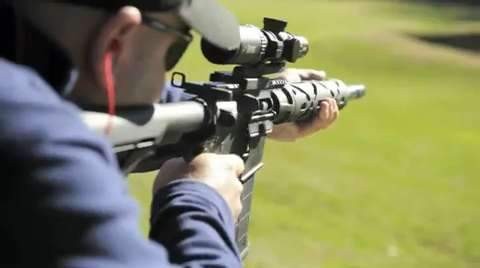
Eye relief is when you finally take your eye away from the scope, rub it, and relax. Just kidding. Eye relief is actually the distance your eye needs to be from the ocular lens to make the scope’s image focus at the back of your eye. This can be a very specific distance, called “critical eye relief”, or it can be a range, depending on the optics. On modern scopes it’s usually in the 2-4 inch range.
When your eye is at the correct distance from the scope, the picture will appear to neatly fill the eyepiece. When you’re too close, the image will fill only part of the eyepiece. When you’re too far, the eyepiece will show only part of the image.
Eye relief became the standard for a simple reason: When shooting a rifle with considerable recoil, your eye would likely get injured if you put it up to the ocular lens like you do with binoculars or a spotting scope. Eye relief prevents a lot of black eyes.
The eye relief on a given scope, relative to your cheek weld (where your cheek rests against the rifle’s stock), determines where the scope must be mounted. This leads to stocks like the Magpul PRS, where the stock length and cheek riser are both adjustable to help you set it up properly.
TURRETS
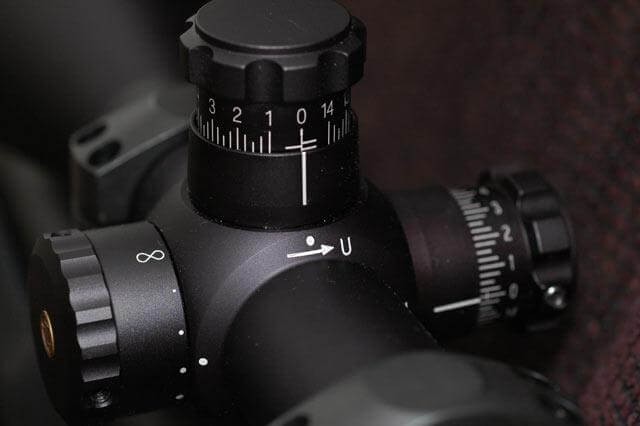
Let’s talk real briefly about something called “MOA.” MOA stands for “minute of angle,” and it’s one of the phrases you hear all the time in precision shooting. (Except for military snipers, who tend to talk in mil-dots.) It comes from geometry, where, as everybody knows, a circle is divided into 360 degrees.
Each of those degrees is divided into 60 “minutes” of angle, and, if you go further, each MOA is divided into 60 “seconds,” like a clock. Shooters don’t generally go that far, though, since from where your rifle sits, one minute of angle is equal (subtends!) to about one inch at a range of 100 yards.
If you’re sighted on the bullseye, and you’re consistently shooting about two inches right and an inch low, you’ll want to adjust your scope 2 MOA to the left and 1 MOA up.
(On mil-dot scopes, which are metric, a turret click usually changes point of impact 1 cm at 100 meters, or 10 cm at 1000 meters. DO NOT confuse this with, for instance, a turret with 1/4 MOA clicks, which change point of impact 7mm at 100 meters.)
Near the center of the scope’s tube is a group of lenses, or optical elements, mounted to move as a unit. These are connected to the turrets, which adjust them either for elevation (vertical) or windage (horizontal). The turrets will usually have very positive detents, creating a click you can feel and hear for each increment of adjustment — usually either 1/4 or, on some higher power scopes, 1/8 MOA.
Remember, that’s either 1/4 inch or 1/8 inch adjustment at 100 yards. At 400 yards that would be increments of 1 inch or 1/2 inch. Once you’ve got it dialed in, most turrets will allow you to reset the dials to zero, as a new starting point.
Obviously, since the turret adjustments are moving the optics inside the scope’s tube, there’s a finite limit of adjustment before it can’t go any further. On most scopes that’ll be between 40 and 80 MOA.
You may see a lot of the higher-priced, higher-powered scopes having less of an adjustment range. That doesn’t mean they’re offering you less. An AR-15 scope that goes to 20x may offer 40 MOA of adjustment rather than the 80 found on a scope that goes to 9x, but at 1000 yards that 40 MOA is 400 inches — 33.33 feet — in your target zone, in increments of 1 1/2 inches per click.
Incidentally, most good AR barrels will generally shoot with about 2-MOA accuracy, and a “match” barrel will shoot with sub-MOA accuracy — that is, in expert hands it can consistently shoot within a 1″ circle at 100 yards. That would translate to a 10″ circle at 1000 yards, but .223 or 5.56 ammo will have pretty much run out of steam by then. For that kind of shooting you might want to upgrade to a .308, or something bigger.
PHYSICAL SIZE AND MOUNTING
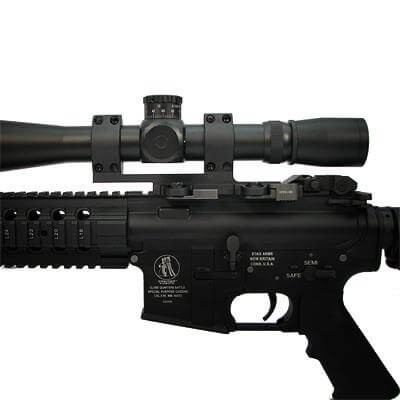
Mounting AR-15 Scopes
For optical reasons, it’s best to mount the scope as close to the bore axis as possible. This also makes the weapon easier to handle, as it keeps the mass close to the long axis of gravity.
But there’s a problem here, a competing physical factor: Except for the AR and its relatives, most rifles have a stock that contacts your shoulder a little below the bore axis. This allows sights mounted directly on the barrel, because your eye is naturally higher than your shoulder. In designing the AR, Eugene Stoner decided to use a straight-line design from the muzzle to the butt, enabling the buffer and spring to absorb recoil.
In terms of physics, this straight-line design also moves the center of recoil force much closer to the weapon’s center of gravity, to help minimize muzzle climb. It’s compensated by mounting the sights higher, on the iconic carrying handle and front sight base — again, because your eyeball is higher than your shoulder.
And the first scopes for the M-16 mounted on top of that, a little higher still.
Now we have people mounting scopes as low as possible over the barrel. But while you can’t really use iron sights below most scope mountings, it’s still good to give the scope some breathing room between the rail and the scope itself. It improves your ergonomics, raising the scope back up to your natural eyeball level, and it also helps it clear the rifle’s charging handle.
(Incidentally, once the scope takes over the top rail of your weapon, and its line of sight, you can still use iron sights. The answer is to get a set of 45-degree offset sights, such as these from AT3 Tactical, or these cool ones from Diamondhead that actually fold inline.)
You may choose an offset mount to move the scope forward to clear the charging handle, but – depending on the scope’s eye relief – that might not be an option.
In such a case, you might find yourself looking at high-rise scope mounts, or even a separate riser piece to mount them on.
And once either of those options happens, you might have to adjust either the height of your cheek weld, or the length of your stock, or both, to maintain optimum eye positioning relative to the scope. Suddenly all the adjustments on stocks like Magpul’s PRS make a lot more sense, don’t they?
Inclination and Cant
One more point worth mentioning: Inclination and cant. The ballistic curve of a flying bullet is a parabola, modified by aerodynamic drag. You don’t need to know the specifics of this, but you should understand that a bullet fired at an upward or downward inclination won’t drop the same as one fired level.
And if you rotate the rifle somewhat on your shoulder, the elevation markers on the reticle get angled relative to the bullet’s flight path. Some of the more sophisticated scopes come with built-in levels to tell you when you’re off level.
For scopes that don’t, there are scope mounts that include bubble levels at a reasonable price. Of course, your eyeballs have their own idea of what’s level and what’s inclined, and it’s usually accurate enough to let you estimate and adjust in all but long-distance or extreme angled shots.
There is no single simple answer to all this. Just remember: Large objective lenses require high mounting, and make the scope heavier. Long scopes and low mountings may interfere with charging the weapon. And moving the scope forward or elevating it might require changes in the stock.
LENS CAPS AND MORE
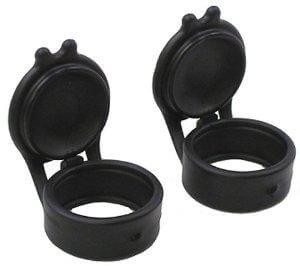
Of course, all this expensive glass needs to be protected when you’re not looking through it. Lens caps come in two basic flavors: “Bikini” style and flip-up.
The basic “bikini” caps were invented to keep individual caps from falling off and getting lost. The front and back caps are simply joined by bands of elastic to keep them under tension, leading to the “bikini” nickname.
Of course, you’ll want to take those caps off to use the scope, and once you do, they can get lost together. The answer to this is flip-up caps – rather than lifting off the scope, they simply pivot upward. Upgrading from bikini to flip-up caps is one of the first and easiest things to do to make handling your scope easier.
Some caps, either flip-up or bikini-style, are clear rather than opaque. While looking through them will never be as optically clear as looking through just the scope, clear lens caps can allow you to sight through the scope without removing them, which can be useful in snapping off a quick shot under pressure.
When you face toward the sun, unless you’re shooting from a shaded position, there’s a good chance that direct sunlight can fall on the lens. This can have a number of undesirable effects: 1) If the lens surface has become dusty, the sunlight striking the dust can “wash out” the image, like sunlight striking a dirty windshield on a car; and 2) Sunlight can cause lens flare on the optics inside the lens, creating a cinematically pleasing effect that makes the scope harder to use. The original and simple answer to this problem is the lens shade, generally a section of flat black tubing that attaches and provides a shadow for the objective lens. It’s worth noting that an opaque flip-up lens cap, flipped to just 90 degrees, can often serve the same function — when the sun’s angle cooperates.
In military use, one of the giveaways that can alert the enemy to a shooter’s presence is the telltale glint of sunlight on a scope’s objective lens.
In the 1980s a solution was invented to minimize this: Anti-reflection devices are made of a hexagonal mesh screen, coated in flat black, that allows light to pass but prevents direct sunlight from reflecting on the glass. Mounted immediately in front of the objective lens, the light degradation is minimal, and the device is so far out of the scope’s focus range that it’s invisible through the scope.
Anti-reflection devices were initially intended for combat use when someone else is looking for you. But they have the happy side effect of eliminating lens flare inside the scope, which makes it worthwhile for many more shooters than just military users.
FULL CIRCLE: What it all means to how you shoot

Remember the question we started with: What is your intended use? Let’s take a look at some of the ways you might shoot, and what’s good for each of them.
Shooting 100 yd targets? Maybe the easiest one to answer: If all you’ll be doing is shooting for pleasure at a fairly constant range, a fixed focal length scope (like that 6x) might be just the thing. It’s likely to be smaller, lighter, and less expensive than a variable power optic, and with fewer elements, there’s a chance it’ll be more rugged, too.
Sniping at 600 meters? For what I call the “hobbyist sniper” — that means the guys who spend thousands on rifles and glass, carefully calculate their own custom handloads, and spend weekends at the range with their ballistic charts memorized, consistently pushing those bullets to the extremes of their reach — the answer is simple: Buy a high power, high quality scope. Some say the guideline is that the scope should cost as much as the rifle. Some say they spend three times as much on glass.
Competing in 3-Gun or similar events? Practical shooting is a fun and rapidly growing sport, teaching valuable skills that most of us hope we’ll never have to use off the range.
Most practical shooting events emphasize speed — that means fast target acquisition, fast, accurate shooting, and then quickly moving on to the next point. Since it’s a simulation of combat, a lot of the requirements are similar. You might do well with a 1x optic like an Eotech to get you on target quickly for the closer ranges.
For distances beyond 100 meters, though, you might want some magnification. That’s where the low-power zooms, like the 1-4x or 1-6x, can help you be fast and accurate.
Killing gophers on the ranch? You could spend your day surveying gopher holes and plotting the distance from each to the shooting bench on your porch. You’ll want to plant little flags with the range beside each hole.
More likely, you have to be ready to shoot at a variety of ranges. Gophers (and other varmints) don’t always appear where you want them to, so a good, mid-range variable scope like a 3-9x might be best. If you’ll be shooting at dusk or in low light, consider large objective lenses, high light transmission, and illuminated reticles.
Also, if you’re shooting from a bench rest, and not carrying the weapon on a long hike, you’re a lot less worried about weight.
Taking on a five day hunting trek? You’ll be shooting at all light levels, at medium to long ranges, and at unpredictable targets. You want a mid-to-long range variable scope, with the max depending on the range of your weapon. But be aware of weight, because you’ll be carrying it a lot, and it only gets heavier as the days go on.
Taking into combat in a war zone? This is the extreme. This is where you replace that black scope with something like OD or FDE for low visibility because somebody might be looking for you. You want the most durable and dependable optic you can get, and it’s a good idea to put an anti-reflection device on the objective lens.
If you’re likely to engage at short ranges, a 1x optic like an Aimpoint or Eotech might be best. If you’re a designated marksman, shooting over longer ranges, a medium-to-long variable scope is probably what you need. And if you’re a sniper then you’ll suit your weapon’s optics to the environment and the mission.
To all our service personnel — best of luck, come home safely, and know that we appreciate what you do!
Article by Wayne Anderson
One Last Tip
If there’s anyone that knows the AR-15 platform, it’s the US military. As a special offer for our readers, you can get the Official US Army Manual for AR-15/M4/M16 right now – for free. Click here to snag a copy.




Best, and most concise article i have ever read regarding scope “innards” and selections! Thank you for the great information!
Great information to share
We were taught as an agency that all scope turrets are to be adjusted in clockwise direction.. If a turret is to be backed off 10 clicks them back it off 25 clicks and run the turret in a clockwise direction 15 clicks for a final adjustment.. Commonly for cheaper scopes removing the slop from the turret and keeping on target every time..
Great article, thank you for sharing your knowledge and experience. I stumbled across this while I was shopping for either a red dot or maybe a low power variable scope. Thank you AT3, for hosting the info, this is equivalent to lucking out and finding the perfect counter rep. at the gun shop.
I think you might want to mention in your eye relief section the diameter of the exit pupil. This is usually calculated as the diameter of the objective lens divided by the power of the scope. This is important because gaining the center of the scope at high power requires finding the image in the exit pupil. If it is small, it is harder to find and hold in a shaky situation. Thus for high magnification a big objective is required. Buying a high variable magnification scope with a small objective can be frustrating at high magnification. One rule of thumb is to look for around a 3mm exit pupil at the highest magnification. Of course, what constitutes too small an exit pupil is up to the individual.
Found information very informative. A little technical for me but allows me to be able to ask the right questions for my needs. Overall very pleased!
Wow, what an informative article! Great job.
I just read Wayne Andersons article and was educated on a confusing subject! Thanks for keeping this info out there AT3 Tactical! This helps to make better choices in scope selections.
What’s your opinion on scopes for the A2 carryhandle? Now that should narrow down the hunt a good bit. Currently I have 2 scopes I run with, A Nikon 3×32 & a colt 4×20. I think I like the Nikon better cause of the eye relief. Any thoughts?
All I will be doing with my aunt is target shooting. I assume that six X will be the best for me . Maybe with a red dot I don’t know?
Generally a pretty good primer on scopes. I have toi disagree about getting a few extra hundred yards out of the .300 blackout over the .223. The .300 blk simply is a short range round having the trajectory of a mortar round. You can’t make it better than the 7.62x39mm, which is inferior to the .223. Add a 220 grain bullet to the .300 blk and it is a 200m round at best.
I need a good scope for my AR-15
Great article explained expertly. I have a BCA M4 and wanted to find the best scope for me. This article has been the best, most clearly concise, article I’ve read. Thanks for breaking it down so its as easy to understand as possible. I was wanting a scope to shoot 100 yards to 300 yards. Guess I’ll be going with a good 1x6x with a good objective lens.
Thanks again. 🙂
This is by far the most concise article on scopes I’ve ever read. It is a “must read” for anyone overwhelmed by the technicalities associated with selecting a scope. Just what I was looking for. Well done.
Lot of great information. Please send ÀR military manual, Thanks Mike?
article what is the best scope for an ar,covered all the bases,very good info
I just read the article on “What’s the best scope for an AR” … the article I’ve read so far and I’ve been researching the internet for over a week everyday. The author deserves a cold beer! He sure can relate to regular people and now I understand 1000% more and feel capable enough to have a conversation with others about scopes. I will always be coming back to this website. Thank you.
Very good info.
I am looking for a 100-500 yard tactile scope that is affordable(up to $500) that exhibits long range targets to appear closer then what they are
Excellent article on how to choose a scope. It quickly decomposes the choices and tradeoffs.
This truly is a fantastic site. I too wish I had all of this information before I purchased my current scope. It’s not that the scope is bad, but I would have gone into the purchase with the knowledge that there were a great many more options than I realized. Of course, we live and learn and will know better in the future
Thanks so much,
George
This is an awesome article, very informative. Thanks for the great read, looking forward to more.
This is a great article. I’m new to the ar club but have hunted for years, so I understood some of this already. I still learned so much more, even corected some of my knowledge. I’m getting ready to build another one maybe in 300 bulk and am looking for a, perfect for me, scope. With the info and guidance in this and your other articles I believe I’ll be able to get the right scope. Thank you so much your articles.
Brilliant article, thank you so much for putting this together. Really helped me get my head around this as I’m new to rifle. Thank you again.
Matt
Think you very much this is an excellent guide! I just wish you worked at my local gun shop! Thanks for your work!
Think you very much this is an excellent guide! I just wish you worked at my local gun shop! Thanks for your work!
Awesome very informative ! Get sum ! god bless america aim small shoot small. Patriots and freedom will remain free if there is faith in god and country !
I wish I’d read this before buying the scope I put on my AR, I’d have made a different choice.
Thanks Wayne. This is the best, most concise, and informative article I’ve read. Most postings are rehashes of another posting.
Ran across it trying to find a good scope choice for my new Colt LESOCOM. But that’s a whole nother problem of it’s own. Seems like every manufacture has the best scopes on the market. I’m new at it, so it will take a while.
Looking forward to more L.A. postings.
The best info web site Ive found thank you very much
Looking for a scope to mount on my DDM4 ISR300 that will allow the most optimal output while using a Night Sniper Hunting Spot light and or a ATN TICO-336A Thermal clip on device. I want the scope to be optimal for both applications.
Thanks!!!
The article on Parallax really made me think about rechecking all my mounted scopes to make sure they are adjusted properly. I really like this site!
Thank you for such in depth articles. Helped me out tremendously and probably saved me hundreds. Thank you.
Great article Wayne. Easy to follow and explained everything I need to make a purchase for my new AR15. Your other articles helped me build my customized rifle for my shooting purposes. Keep these articles coming.
Good info Ive tried many scopes and sights and and I am convinced that my burris mtac,aimpoint pro,and trijicon ta31rco cover every range and situation Ill likely encounter with my ar,s.
Thanks a million Wayne…
I’ve bookmarked this article for later and continued research 7 learning. I’m new to scopes wanting one on both a Mossy 22 mdl 46 and a recently acquired OA AR 15. Very informative article!!
Bruce Orr
Thank you for such in depth articles. Helped me out tremendously and probably saved me hundreds. Thank you.
Nicely written and informative article.!!